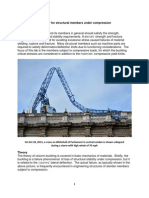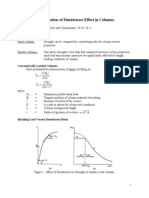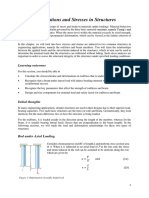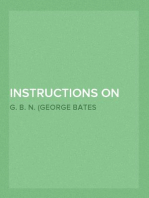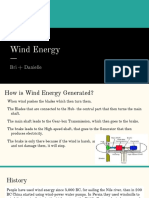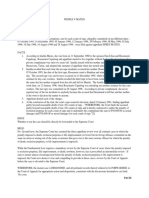Buckling of Column
Uploaded by
Dilan IndikaBuckling of Column
Uploaded by
Dilan IndikaINTRODUCTION
When a perfect column is subjected to a compressive axial force as shown in Figure 1, the only
deformation that takes place is a shortening of the column. For low values of F, if the column were to
be deflected laterally by a force perpendicular to the column, and the lateral force were thereafter
removed, the column would return to its straight position, even with the force F remaining in place.
This indicates a condition of stability. If the load F were increased, there is a value of F for which,
when the lateral load is removed, the column would remain in the deformed shape. This condition is
referred to as buckling and the column is said to have failed from a structural standpoint. Buckling can
also be described in simple terms as bending or bowing of a column due to a compressive load. This is
illustrated in Figure 2.
The buckling just described is termed primary instability because the phenomenon occurs
without there being any distortion in the cross section. Secondary instability, another type of
instability, can also occur. This can be demonstrated by buckling a soda straw, where the straw kinks
at a point along its length. The failure is even more dramatic than the onset of the failure that is
displayed by the primary instability.
AIM
Understand the buckling of columns under different orientation of the section and different end
conditions.
APPARATUS
y Column holder.
y 5 test specimens (Metal columns).
y Vernier caliper.
y Loads (1kg, 500g, 200g, 100g).
y Meter ruler.
Figure1 Figure2
Force, F Force, F
Force, F
Force, F
THEORY
Columns can mainly fail by two ways.
y Buckling
y Crushing
If the lengths of beams are higher it can be fail from buckling rather than crushing. We can see that
a beam may experience a sudden change in its configuration Under compression above a critical load
(P
cr
).The critical load is directly proportional to the second moment of area of the cross section(I).It
means the beam always tend to buckle around the axis where the I is minimum. So,
P
cr
I (1)
I=bh
3
/12 @ I
YY
>>> I
XX
(Where b and h are dimensions of the cross section.)
Therefore the force can increased for a same column in different second moment of area of the cross section as
follows.
F
YY
>>>>> F
XX
We also know that the various materials affect buckling differently. So it depend on the property of the
material. this property is given by Yungs modulus(E).So,
P
cr
E (2)
We can also see that the columns with higher lengths can easily buckle than shorter ones under the
same axial force.According to the joint conditions of the end of the column the effective length is
change as figure.
Y
Y
X X
Cross section of a beam
In this practical we used both ends pinned beam.
So P
cr
depends on effective length (L
e
) as follows,
P
cr
1/L
e
2
(3)
From equation (1),(2) & (3) {Euler buckling formula} @
(a)
We also know that, I=AR
2
(b)
Where,
I=second moment
A=crossectional area
R=radius of gyration
From equation a & b @
Where L
e
/R is slenderness ratio (r) and
cr
is critical stress .
PROCEDURE
y Get five test specimens with same cross sectional area and different length.
y Measure the cross sectional dimensions at three different points and get the average values in a
one specimen. We assume that all other specimens have the same cross sectional dimensions.
y Measure the length of each column.
y Each column kept in the column holder as shown in the bellow.
y Then the loads were applied one by one slowly till the column reach buckling point. We give
support to the specimen by our hand to prevent failure from buckling.
y When our hand feels that the column is reached the buckle point, stop adding loads and got the
value of present total mass and previous total mass and average was taken.
DISCUSSION
Application
Buckling Restrained Braced Frame (BRBF)
The concept of eliminating the compression buckling failure mode in intermediate and slender
compression elements has long been a subject of discussion. The theoretical solution for eliminating
the buckling failure mode is very simple: laterally brace a compression element, at close regular
intervals, so that the compression elements un-braced length effectively approaches zero.
Cost advantages of Buckling Restrained Braced Farm
The presented study investigates anticipated cost advantages of Buckling Restrained Braced Frame
(BRBF) systems compared to Concentrically Braced Frame (CBF, Frame with concentric bracings)
systems. The former is a braced frame containing special diagonal members called Buckling
Restrained Braces, characterized by balanced, highly ductile behavior. The latter is a conventional
vertical truss system which is designed so that yielding of the braces in tension will take place before
yielding or buckling of the non-ductile beams or columns or before failure of the connections. Two
types of CBF systems are investigated: a low dissipative CBF with very limited ductility and a
moderately ductile CBF with dissipative X bracing. Design seismic forces are affected by the level of
ductility expected from each solution, thus buildings with BRBF systems have significantly lower
design earthquake loads than their CBF equipped counterparts.
Due to some reasons we can see a different between theoretical and experimental curves. some of the
reasons for this behavior are given below;
y Cross-section could be varying along the column. But we get it as constant.
y The applied force could not be axial to the column. Reason is the beam which gives axial
force to the column is not horizontal. So this beam should be horizontal for correct
readings.
y There could be a initial buckle in the column. But we assume columns are straight. If there
is a initial buckle in the column it is easy to buckle to that direction.so that P
cr
reduces than
theoretical value.
y There could be manufacturing defects in columns.so the columns can easy to buckle.
Therefore P
cr
reduced.
y When loads are applying we touch the column and feel that the column going to buckle and
then get the reading.so there could be errors when we recognize the buckling point.
y Ideal end conditions cant be obtained in practically (pinned, fixed).
y Impact forces applied when putting weights reduced P
cr
.
y Friction losses can cause.
y Measurement errors (width, highs, cross sections).
y Actual youngs module can be differ from literature one.
For a good mechanical structure we must apply conditions to prevent failures of columns by buckling
y Use proper material for the requirement
y Designing columns as they have higher second moment.
y Use proper end conditions for columns. Both ends fixed columns can bear more load.
y Use of columns with lower height as far as possible.
y Applied suitable loads which column can bear.
CALCULATION
Calculation for P
cr
(Theoretical) of column number 1:-
P
EI
L
= 98.06 (Nm
-2
)
Calculation for P
cr
(Practical) of column number 1:-
P
ci
Piactical
mg L
Calculation for
cr
and r of column number 1:-
A
ciTheoietical 10
-6
(Nm
-2
) = 1.7203510
6
(Nm
-2
)
ciPiactical 10
-6
(Nm
-2
) = 1.6759610
6
(Nm
-2
)
r = L
e
/R
r = 0.545/8.6610
-4
Column No: r
cr
(Theoretical) (Nm
-2
)
cr
(Practical) (Nm
-2
)
1 629.330 1.7203510
6
1.6759610
6
2 563.510 2.1457910
6
2.1131610
6
3 458.430 3.2421110
6
3.3021110
6
4 414.550 3.9649110
6
3.4249110
6
5 400.693 4.2436810
6
3.8621110
6
You might also like
- Elemen Struktur Baja-III. COMPRESSION STRUCTURENo ratings yetElemen Struktur Baja-III. COMPRESSION STRUCTURE27 pages
- LAB 5 Buckling and Structural Stability Under CompressionNo ratings yetLAB 5 Buckling and Structural Stability Under Compression11 pages
- 23AE60R01 Expt5 AerospaceStructuresLaboratoryNo ratings yet23AE60R01 Expt5 AerospaceStructuresLaboratory8 pages
- Inv. U4 Inest. Elastica en Las Columnas-JalmNo ratings yetInv. U4 Inest. Elastica en Las Columnas-Jalm14 pages
- Columns and Struts: Presented By: Er. Ravinder Panwar A.P. (Dept. of Ce)No ratings yetColumns and Struts: Presented By: Er. Ravinder Panwar A.P. (Dept. of Ce)26 pages
- Slender Column Test For Different End CondNo ratings yetSlender Column Test For Different End Cond4 pages
- Experiment No.: 5 Test of Slender Column: 1. ObjectivesNo ratings yetExperiment No.: 5 Test of Slender Column: 1. Objectives6 pages
- Instructions on Modern American Bridge BuildingFrom EverandInstructions on Modern American Bridge BuildingNo ratings yet
- Theory of Elastisity, Stability and Dynamics of Structures Common ProblemsFrom EverandTheory of Elastisity, Stability and Dynamics of Structures Common ProblemsNo ratings yet
- Business Plan Template Grade 9 Final Exam Performance Task100% (1)Business Plan Template Grade 9 Final Exam Performance Task17 pages
- Topic2 - Influence Lines For Statically Indeterminate BeamsNo ratings yetTopic2 - Influence Lines For Statically Indeterminate Beams21 pages
- Lecture # 2 Technology Infrastructure: The Internet and The World Wide WebNo ratings yetLecture # 2 Technology Infrastructure: The Internet and The World Wide Web35 pages
- Supply Chain Management: An International Journal: Article InformationNo ratings yetSupply Chain Management: An International Journal: Article Information15 pages
- Cadbury Presentation - Group 3 - Consumer Behavior0% (1)Cadbury Presentation - Group 3 - Consumer Behavior28 pages
- Jurnal Penelitian Transportasi Darat: Kajian Preferensi Masyarakat Dalam Menggunakan LRT JabodebekNo ratings yetJurnal Penelitian Transportasi Darat: Kajian Preferensi Masyarakat Dalam Menggunakan LRT Jabodebek8 pages
- Bagaimanakah Beban Kerja Dan Stres Kerja Mempengaruhi Kinerja Karyawan Dengan Burnout Sebagai Variabel MediasiNo ratings yetBagaimanakah Beban Kerja Dan Stres Kerja Mempengaruhi Kinerja Karyawan Dengan Burnout Sebagai Variabel Mediasi14 pages
- Megamare Orto Parisi perfume - a fragrance for women and men 2019No ratings yetMegamare Orto Parisi perfume - a fragrance for women and men 20191 page
- Solution Manual for Materials for Civil and Construction Engineers 3rd Edition by Mamlouk 2024 scribd download100% (11)Solution Manual for Materials for Civil and Construction Engineers 3rd Edition by Mamlouk 2024 scribd download54 pages
- Analisis Pencemaran Logam Berat Timbal Di Badan Sungai Babon Kecamatan Genuk SemarangNo ratings yetAnalisis Pencemaran Logam Berat Timbal Di Badan Sungai Babon Kecamatan Genuk Semarang7 pages
- Crate Conditioning of Bongo (Tragelaphus Eurycerus) For Veterinary and Husbandry Procedures at The Denver Zoological GardensNo ratings yetCrate Conditioning of Bongo (Tragelaphus Eurycerus) For Veterinary and Husbandry Procedures at The Denver Zoological Gardens8 pages
- LAB 5 Buckling and Structural Stability Under CompressionLAB 5 Buckling and Structural Stability Under Compression
- Columns and Struts: Presented By: Er. Ravinder Panwar A.P. (Dept. of Ce)Columns and Struts: Presented By: Er. Ravinder Panwar A.P. (Dept. of Ce)
- Experiment No.: 5 Test of Slender Column: 1. ObjectivesExperiment No.: 5 Test of Slender Column: 1. Objectives
- Instructions on Modern American Bridge BuildingFrom EverandInstructions on Modern American Bridge Building
- A Mathematical Study of Cantilever Bridge DesignFrom EverandA Mathematical Study of Cantilever Bridge Design
- Theory of Elastisity, Stability and Dynamics of Structures Common ProblemsFrom EverandTheory of Elastisity, Stability and Dynamics of Structures Common Problems
- Business Plan Template Grade 9 Final Exam Performance TaskBusiness Plan Template Grade 9 Final Exam Performance Task
- Topic2 - Influence Lines For Statically Indeterminate BeamsTopic2 - Influence Lines For Statically Indeterminate Beams
- Lecture # 2 Technology Infrastructure: The Internet and The World Wide WebLecture # 2 Technology Infrastructure: The Internet and The World Wide Web
- Supply Chain Management: An International Journal: Article InformationSupply Chain Management: An International Journal: Article Information
- Cadbury Presentation - Group 3 - Consumer BehaviorCadbury Presentation - Group 3 - Consumer Behavior
- Jurnal Penelitian Transportasi Darat: Kajian Preferensi Masyarakat Dalam Menggunakan LRT JabodebekJurnal Penelitian Transportasi Darat: Kajian Preferensi Masyarakat Dalam Menggunakan LRT Jabodebek
- Bagaimanakah Beban Kerja Dan Stres Kerja Mempengaruhi Kinerja Karyawan Dengan Burnout Sebagai Variabel MediasiBagaimanakah Beban Kerja Dan Stres Kerja Mempengaruhi Kinerja Karyawan Dengan Burnout Sebagai Variabel Mediasi
- Megamare Orto Parisi perfume - a fragrance for women and men 2019Megamare Orto Parisi perfume - a fragrance for women and men 2019
- Solution Manual for Materials for Civil and Construction Engineers 3rd Edition by Mamlouk 2024 scribd downloadSolution Manual for Materials for Civil and Construction Engineers 3rd Edition by Mamlouk 2024 scribd download
- Analisis Pencemaran Logam Berat Timbal Di Badan Sungai Babon Kecamatan Genuk SemarangAnalisis Pencemaran Logam Berat Timbal Di Badan Sungai Babon Kecamatan Genuk Semarang
- Crate Conditioning of Bongo (Tragelaphus Eurycerus) For Veterinary and Husbandry Procedures at The Denver Zoological GardensCrate Conditioning of Bongo (Tragelaphus Eurycerus) For Veterinary and Husbandry Procedures at The Denver Zoological Gardens

















